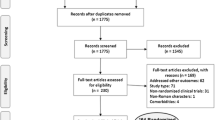Abstract
Hepatitis C is a virus affecting millions worldwide and is a major health risk. With the potentially severe adverse event profile of the current backbone of therapy, interferon, there is an impetus to discover interferon free treatment regimens. With the development of new oral direct acting antivirals, interferon free regimens may be available in the next few years. This article discusses some of the preliminary data from interferon free studies.
Similar content being viewed by others
References
Papers of particular interest, published recently, have been highlighted as: • Of importance
Choo QL, Kuo G, Weiner AJ, et al. Isolation of a cDNA clone derived from a blood-borne non-A, non-B viral hepatitis genome. Science. 1989;21(244):359–62.
Poynard T, Marcellin P, Lee SS, et al. Randomised trial of interferon alpha2b plus ribavirin for 48 weeks or for 24 weeks versus interferon alpha2b plus placebo for 48 weeks for treatment of chronic infection with hepatitis C virus. International Hepatitis Interventional Therapy Group (IHIT). Lancet. 1998;352:1426–332.
McHutchinson JG, Gordon SC, Schiff ER, et al. Interferon alfa-2b alone or in combination with ribavirin as initial treatment for chronic hepatitis C. N Engl J Med. 1998;339:1485–92.
Poynard T, Marcellin P, Lee SS, et al. Randomised trial of interferon alpha2b plus ribavirin for 48 weeks or for 24 weeks versus interferon alpha2b plus placebo for 48 weeks for treatment of chronic infection with hepatitis C virus. Lancet. 1998;352(9138):1426–32.
Glue P, Fang JW, Rouzier-Panis R, et al. Pegylated interferon-alpha2b: pharmacokinetics, pharmacodynamics, safety, and preliminary efficacy data. Clin Pharmacol Ther. 2000;68(5):556–67.
Grace M, Youngster S, Gitlin G, et al. Structural and biologic characterization of pegylated recombinant IFN-alpha2b. J Interferon Cytokine Res. 2001;21(12):1103–15.
Bailon P, Palleroni A, Schaffer CA, et al. Rational design of a potent, long-lasting form of interferon: a 40 kDa branched polyethylene glycol-conjugated interferon a-2a for the treatment of hepatitis C. Bioconjug Chem. 2001;12(2):195–202.
Manns MP, McHutchison JG, Gordon SC, et al. Peginterferon alfa-2b plus ribavirin compared with interferon alfa-2b plus ribavirin for initial treatment of chronic hepatitis C: a randomised trial. Lancet. 2001;358(9286):958–65.
Fried MW, Shiffman ML, Reddy KR, et al. Peginterferon alfa-2a plus ribavirin for chronic hepatitis C virus infection. N Engl J Med. 2002;347(13):975–82.
McHutchison JG, Lawitz EJ, Shiffman ML, et al. Peginterferon alfa-2b or alfa-2a with ribavirin for treatment of hepatitis C infection. N Eng J Med. 2009;361:580–93.
Flamm S, Lawitz E, Jacobson I, et al. High Sustained Virologic Response (SVR) among genotype 1 previous non-responders and relapsers to peginterferon/ribavirin when re-treated with boceprevir (BOC) plus peginterferon alfa-2A/ribavirin. J Hepatol. 2011;54:A1366.
Bacon BR, Gordon SC, Lawitz E, et al. Boceprevir for previously treated chronic HCV genotype 1 infection. N Engl J Med. 2011;364:1207–17.
Poordad F, Chee GM: Pharmacology and mechanisms of action of antiviral drugs: Ribavirin analogues. Advanced Therapy for Hepatitis C Infection. 2011, Wiley-Blackwell (In press)
Fried MW, Shiffman ML, Reddy KR, et al. Peginterferon alfa-2a plus ribavirin for chronic hepatitis C virus infection. N Engl J Med. 2002;347:975–82.
Poordad F, McCone Jr J, Bacon BR, et al. Boceprevir for untreated chronic HCV genotype 1 infection. N Engl J Med. 2011;364:1195–206.
Jacobson IM, McHutchison JG, Dusheiko G, et al. Telaprevir for previously untreated chronic hepatitis C virus infection. N Engl J Med. 2011;364:2405–16.
Gale M, Katze MG. Molecular mechanisms of interferon resistance mediated by viral-directed inhibition of PKR, the interferon induced protein kinase. Pharmacol Ther. 1998;78:29–46.
Ge D, Fellay J, Thompson AJ, et al. Genetic variation in IL28B predicts hepatitis C treatment-induced viral clearance. Nature. 2009;461:399–401.
• Thompson AJ, Muir AJ, Sulkowski MS, et al.: IL28B Polymorphism Improves Viral Kinetics and Is the Strongest Pre-treatment Predictor of SVR in HCV-1 Patients. Gastroenterology. 2010; 139:120–129. A key paper describing the clinical effects of the IL28B polymorphism on response rates in HCV genotype 1 patients.
Poordad F, Bronowicki J-P, Gordon SC, et al.: IL28B Polymorphism Predicts Virologic Response in Patients With Hepatitis C Genotype 1 Treated With Boceprevir (Boc) Combination Therapy. Gastroenterology 2011;A1864
Zeuzem S, Andreone P, Pol S, et al. REALIZE study team: telaprevir for retreatment of HCV infection. N Engl J Med. 2011;364(25):2417–28.
• Gane EJ, Roberts SK, Stedman CA, et al.: Oral combination therapy with a nucleoside polymerase inhibitor (RG7128) and danoprevir for chronic hepatitis C genotype 1 infection (INFORM-1): a randomised, double-blind, placebo-controlled, dose-escalation trial. Lancet. 2010;376:1467–75. The first study assessing two compounds with different mechanisms of action targeting HCV and showing good antiviral effects. This ultimately allowed for the discussion of interferon free regimens.
• Lok A, Gardiner D, Lawitz E, et al.: Quadruple therapy with MBS-790052, BMS-650032 and peginterferon/ribavirin for 24 weeks results in 100% SVR12 in HCV genotype 1 null responders. J Hepatol 2011; 54(suppl):S536. An important study, and the first to show that null patients can be cured of HCV using only 2 oral agents for 24 weeks. This presentation changed many perspectives about the possibilities of what interferon free regimens can do.
Lalezari J, Lawitz E, Rodriguez-Torres M, et al. PSI-7977 QD with Peg/RBV: 12-week Safety, RVR, cEVR, and SVR12 in treatment-naïve patients with HCV GT2 or GT3. J of Hepatology. 2011;54:A61.
Lawitz E, Rodriguez-Torres M, Denning J, et al. Once daily dual-nucleotide combination of PSI-928 and PSI-7977 provides 95% HCV RNA<LOD at Day 14: first purine/prymimidine clinical combination data (The Nuclear Study). J Hepatol. 2011;54:A1370.
Disclosure
F. Poordad has received consultant fees and grant funding from Merck, Vertex, Gilead, Pharmassett, Anadys, Achillion, BMS, Abbott and Genentech, and has received payment for development of educational presentations from Vertex, Merck, Genentech, and Gilead; G. Chee reported no potential conflicts of interest relevant to this article.
Author information
Authors and Affiliations
Corresponding author
Rights and permissions
About this article
Cite this article
Poordad, F., Chee, G.M. Interferon Free Hepatitis C Treatment Regimens: The Beginning of Another Era. Curr Gastroenterol Rep 14, 74–77 (2012). https://doi.org/10.1007/s11894-011-0229-1
Published:
Issue Date:
DOI: https://doi.org/10.1007/s11894-011-0229-1




